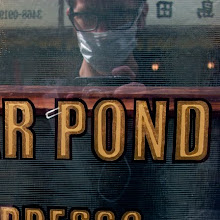Though I've done my share of frequenting (and hyping) the so-called 'bad boy artist' exhibits currently on 'round the city, I balance that w/ proper Minimalism. Like pork belly + beet salad. Now there are some misnomers when it comes to Minimalism and minimalist artists, that they're all stoic, static, oppressively unmoving. You might think of Kazimir Malevich's painted 'Black Square's (Suprematism) or Mark Rothko's late-work plums and purplish-blacks (like those on view at the Rothko Chapel in Houston TX) which are technically color-field, or the fluorescent light works by Dan Flavin. OK so far, I guess. So let's throw in one of the obvious modern masters who's still doing it, and doing it brilliantly: Robert Ryman, he of the so-called 'white paintings', five decades of 'em. Ryman has a brilliant exhibition of new works, spanning his creative vocabulary, at Pacewildenstein uptown and it is anything BUT stoic/static. And despite the fact that the 30 works are mostly the same squarish size (usually 10" to 30" around), they're anything BUT boring. Same deal w/ Scotland's Callum Innes, who in a few words could be called an 'unpainter' — as his stuff may begin as a monochrome (even hardedge or color-field), until he vigorously 'un-paints' part of it, via turpentine, creating a very different, very active minimalist monochromatic new piece. His new show at Sean Kelly Gallery, coupled w/ Ryman's, is a fantastic instance of what I'm calling 'action minimalism'. Dig it? Read on.
Ryman's oeuvre sounds deceptively simple, varieties of white paint on varieties of backings (cloth, wood, metal etc), but the end results are practically endlessly varied. Ryman tweaks bits of each work, adds something new here, changes the size of the painted field, leaves part of the penciled-in grid, reworks the support mechanisms etc, to create loads of new results. But he furthers this experimentation, to the delightful benefit of us, the viewers, by meticulously working w/ the gallery lighting. THIS is where Ryman's paintings come alive, far beyond anything that could be captured in a catalogue. This is why when you walk into the room you'll note the gallery has added partitions and soft incandescents to 'activate' the paintings, drawing out the nuances that makes each work unique. An easy example straight away is how shiny and textured the paintings on wood are, how the grain of the wood bleeds through the paint (except in a few instances where he added additional cloudy grayish-white shapes, quite nearly like color-field, that obliterate all beneath it). Contrast w/ the paintings on MDF, shimmering like Eagle-Brand condensed milk, reflecting the room w/in it, but w/ no trace of the board's surface. Especially note the difference w/ the one stretched-cotton work, mounted on wood, and how 'flat' the white is, compared to the wood/MDF surfaces. Ryman's usage of Tyvek is also intriguing, as the solid-white bleeds into the gallery walls, permitting anything on it (an eggshell coloring, or gray-white) to literally bounce off the surface. Never have I been more aware of the gallery walls than at a Ryman show. You catch yourself comparing 'true white'. Ryman says "it is not just the intensity of the light, but the direction of the source that is important, and in each light situation the paintings [look] different". This exhibition is a brilliant chance to take advantage of looking for these differences — and differences in experience — and realizing the complexity of Ryman's work.
On paper, Innes' new series look like divided monochromes, one half white, the other half some color (and a few appear totally white, divided down the middle by a line a la Barnett Newman). Guess what: there is a LOT going on here, but you need to see them in person. Gallery lighting is a benefit, but another is just being in the presence of these paintings to immediately pick up on what's at play here. I detailed the path of least resistance in a previous LIST, but your best bet is to head straight in towards this glowing lemony yellow canvas and note its matte whitish half. I'm talking about the original gesso layer, what once was also lemony yellow until Innes took his turpentine-soaked brush and painstakingly obliterated the color. EXCEPT check the side of the canvas: you'll note spare traces of dry paint, which tend towards a whole rainbow of hues, not just the apparent yellow — which makes one wonder if there are other colors tucked beneath the apparent outer layer). The interplay b/w paint and gesso is especially clear in the white/white pairing on the inner wall. The half w/ paint shimmers like an expanse of White-Out while the gesso'd half is flat like a pencil eraser took a go at it. But again, the sides belie the energy Innes had to enact to rid it of color, even if that color should be white. Same deal w/ the gesso/black paintings: one has a reddish undertone, the other a greenish, but you'd only know that by seeing the leftovers on the gesso'd side. So besides the reverberating, shining color (whatever color that may be), there is a lot of spent energy on the other half of all these paintings. A lot of action happened to make these, and action is required of us to investigate just what is going on with them. It is to our betterment that we can check these out from multiple POVs, just like seeing the Ryman paintings from different angles and distances.
So my point is: Minimalism as a term and a theory can be VERY deceptive. It's not 'easy' nor a 'cop-out' for one's attention span. You have to pay attention to these, you have to be willing to take a role in checking them out. Only then does the action of these on-the-surface minimalist works come out, kinetic-like, interacting w/ the viewer.
skip to main |
skip to sidebar

